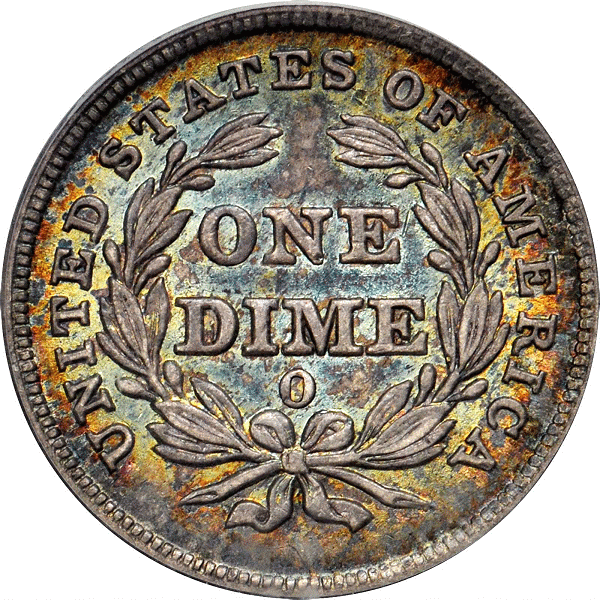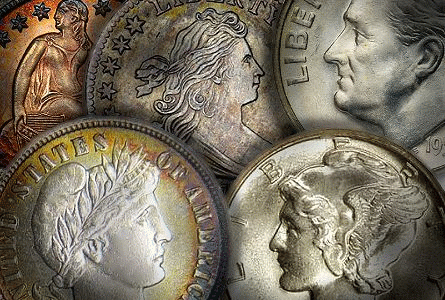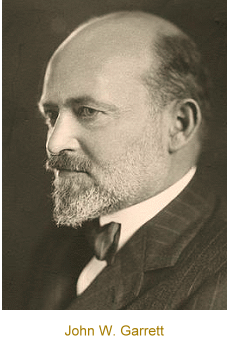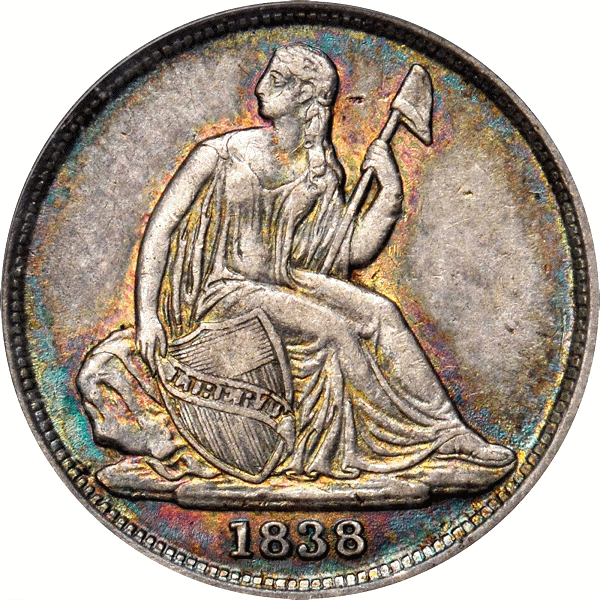Coin Rarities & Related Topics: News and Analysis regarding scarce coins, coin markets, and the coin collecting community, #286
A Weekly CoinWeek Column by Greg Reynolds ……….
The 1838-O dime is an inaugural issue of the New Orleans Mint and is the only Branch Mint representative of the first design type of Liberty Seated Dimes, without stars. On Friday, Stack’s-Bowers will auction a PCGS graded Extremely Fine-45 1838-O, which is CAC approved. This 1838-O was formerly in the Garrett Family Collection and is now in the collection of the late Douglas Kaselitz.
The Garrett-Kaselitz 1838-O is relatively affordable, given its eye appeal, pedigree, scarcity and historical significance. Indeed, it is a wonderful coin that will cost much less than many higher quality, similar coins from the same era.
Last week, the focus was on the Kaselitz gem quality 1831 quarter and general information about the Kaselitz Collection was provided. This week, Stack’s-Bowers is auctioning an assortment of coins from many different consignors at the Baltimore Convention Center. Most of the coins in the Kaselitz Collection, including this 1838-O, will be sold during Friday night.
Affordability
This same 1838-O dime was graded Extremely Fine-40 in the Garrett III sale of October 1980, and then realized $950, according to the PCGS web site. Many of the coins in the Garrett sales were undergraded by current standards.
Markets for rare coins had crashed, in a devastating manner, circa April 1980. Even so, many of the coins in the Garrett sales tended to bring above-market prices during the respective times of the auctions. In retrospect, the $950 result then is difficult to interpret. Also, I am postulating here that someone at Stack’s-Bowers carefully verified that the Kaselitz 1838-O dime and the Garrett 1838-O dime are the same coin.
For an EF-45 grade 1838-O dime, the value currently listed on PCGS CoinFacts is “$885.” The numismedia.com estimate for an EF-40 grade 1838-O is $780 and the estimated value for an AU-50 grade coin is $1050. In June 2014, Stack’s-Bowers auctioned a PCGS graded EF-45 1838-O, without a CAC sticker, for $705. Because of its pedigree, eye appeal and freshness, the Garrett-Kaselitz 1838-O may bring far more than guide values and some past results for similarly certified 1838-O dimes, though it will probably be less costly than a choice ‘mint state’ 1838-O.

Well circulated 1838-O dimes are available to collectors with modest budgets. Last summer, Stack’s-Bowers sold a NGC graded Good-06 1838-O for $57. One in Good-04 grade would probably retail for less than $45. On Sept. 28, 2014, the firm called “GreatCollections” sold a NGC graded AG-03 1838-O dime for $28.02. Excepting Draped Bust coins, assembling a limited type set of silver dimes would not require a fortune. (Clickable links are in blue.)
Design Types of Silver U.S. Dimes
U.S. dimes dating from 1796 to 1837 are approximately 89.24% silver. Those dating from later in 1837 all the way to 1964 were specified to be 90% silver and 10% copper. Dimes dated 1965 and later are of a copper-nickel “clad” composition and do not contain any silver. Starting in 1992, however, the San Francisco Mint again produced some 90% silver Roosevelt dimes though all such silver dimes have been struck in Proof format.
 A type set of silver U.S. dimes requires just thirteen coins: 1) Draped Bust, Small Eagle 1796-97; 2) Draped Bust, Heraldic Eagle 1798-1807; 3) Capped Bust, “Large” 1809-28; 4) Capped Bust, “Small” 1828-37; 5) Liberty Seated, No Stars 1837-38; 6) Liberty Seated with Stars and No Drapery, 1838-40; 7) Liberty Seated with Stars and Drapery, 1840-1853, 1856-60; 8) Liberty Seated — Arrows & Stars 1853-55; 9) Liberty Seated – Legend on Obverse (front), 1860-73, 1875-91; 10) Liberty Seated – Arrows & Legend on Obverse, 1873-74; 11) Barber 1892-1916; 12) Mercury 1916-45; 13) Roosevelt 1946-64, and particular Proofs from 1992 to the present.
A type set of silver U.S. dimes requires just thirteen coins: 1) Draped Bust, Small Eagle 1796-97; 2) Draped Bust, Heraldic Eagle 1798-1807; 3) Capped Bust, “Large” 1809-28; 4) Capped Bust, “Small” 1828-37; 5) Liberty Seated, No Stars 1837-38; 6) Liberty Seated with Stars and No Drapery, 1838-40; 7) Liberty Seated with Stars and Drapery, 1840-1853, 1856-60; 8) Liberty Seated — Arrows & Stars 1853-55; 9) Liberty Seated – Legend on Obverse (front), 1860-73, 1875-91; 10) Liberty Seated – Arrows & Legend on Obverse, 1873-74; 11) Barber 1892-1916; 12) Mercury 1916-45; 13) Roosevelt 1946-64, and particular Proofs from 1992 to the present.
Liberty Seated dimes with no stars in the design were minted for just two years, 1837 and 1838. There are just three major varieties that are collected as distinct dates: 1837 ‘Large Date,’ 1837 ‘Small Date’, and 1838-O. The 1837 issues were struck in Philadelphia and 1838-O dimes were minted in New Orleans. At the Philadelphia Mint, dimes were struck in 1838, though these are of the type with stars and ‘No Drapery’ on the obverse (front). The order for stars to be added to the design was given after dies were shipped to the New Orleans Mint during the spring of 1838.
Branch Mints
Ever since 1793, the headquarters of the U.S. Mint has been in Philadelphia. Indeed, a very large percentage of U.S. coins struck so far have been manufactured in Philadelphia.
In 1838, Branch U.S. Mints were established in New Orleans (LA), Charlotte (NC) and Dahlonega (GA). The San Francisco Mint began formally producing U.S. coins in 1854. The Carson City (Nevada) Mint commenced operations in 1870 and closed in 1893. The Denver Mint began producing coins in 1906.
Currently, U.S. coins are minted in Philadelphia, San Francisco, Denver and West Point (NY). The West Point facility attained formal mint status in 1988, although large quantities of U.S. coins were struck there from 1974 to 1986.
 A main point here is that New Orleans was the first Branch U.S. Mint to strike silver coins and was the only Branch U.S. Mint to produce silver coins until the San Francisco Mint was established. Although the San Francisco Mint began to produce gold coins in 1854, silver coins were not made there until 1855. I have analyzed the only known Proof 1855-S quarter.
A main point here is that New Orleans was the first Branch U.S. Mint to strike silver coins and was the only Branch U.S. Mint to produce silver coins until the San Francisco Mint was established. Although the San Francisco Mint began to produce gold coins in 1854, silver coins were not made there until 1855. I have analyzed the only known Proof 1855-S quarter.
U.S. copper (or “bronze”) coins were never struck in New Orleans. The first U.S. copper coins to be struck outside of Philadelphia were Indian cents at the San Francisco Mint in 1908.
Nickels likewise were never struck at the New Orleans Mint. The first U.S. nickel coins to be minted outside of Philadelphia were 1912-D Liberty Head nickels in Denver and 1912-S nickels in San Francisco. Importantly, 1838-O half dimes, dimes and half dollars are extremely distinctive in the framework of the history of U.S. coinage.
Quarters were not struck in New Orleans until 1840. There are no 1838-O gold coins and 1839-O quarter eagles are rare. There are no 1838-O or 1839-O half eagles ($5 gold coins), and 1840-O half eagles are very rare. The first New Orleans Mint eagle ($10 coin) is the 1841-O, which is extremely rare.
If all 1838-O half dollars were struck in 1839, as is often theorized, the only coins produced at the New Orleans Mint during the calendar year of 1838 were dimes and half dimes. Researchers suggest that more than two-thirds of all 1838-O dimes were struck in 1838, though thousands of 1838-O dimes were minted during the winter of 1839 with an ‘1838’ obverse die.
During 1838 and 1839, there were serious problems at the New Orleans Mint relating to coining machinery, personnel, infrastructure and other matters. The people involved struggled to produce 1838-O dimes and half dimes. These dimes are the most affordable of all the 1838-O issues, the first coins of the New Orleans Mint.
Rarity of 1838-O dimes
Although dedicated specialists collect Liberty Seated dimes ‘by date,’ most of the demand for 1838-O dimes comes from collectors assembling type sets. It is just one of three ‘dates’ of the whole Liberty Seated, No Stars design type of dimes. Many collectors assembling type sets prefer an 1838-O to an 1837 ‘Large Date’ or an 1837 ‘Small Date’ as an 1838-O is a ‘first’ New Orleans Mint product.
The general belief is that 1838-O dimes are scarce, not rare. The PCGS CoinFacts “survival estimate” of “800,” however, seems too high. I hypothesize that the 1838-O dime is rare. A coin is rare if fewer than 500 survive in all states of preservation.
PCGS and NGC together report a total of around 460 graded. This total probably amounts to 300 to 345 different 1838-O dimes. Probably, another 55 to 100 1838-O dimes have never been submitted to PCGS or NGC. There are collections of never certified coins and some collectors of coins that grade below EF-40 find plastic holders to be unnecessary and irritating. There are also some in PCGS ‘Genuine’ or NGC ‘Details’ holders, perhaps 25 to 50. Altogether, I estimate between 380 and 495 survive.
Garrett Distinction
Among the twenty-five all-time greatest collections of American numismatic items, the Garrett Collection is among the most interesting. Although completeness was one objective, the Garretts focused on coins that were rare, unusual, famous, of surprisingly high quality, or otherwise distinctive.
 The PCGS graded ‘MS-66+’ 1795 eagle ($10 gold coin) in the Pogue Collection was formerly in the Garrett Family Collection. It is likely that some of the high quality, pre-1840 half eagles in the Pogue Collection were also earlier owned by the Garretts.
The PCGS graded ‘MS-66+’ 1795 eagle ($10 gold coin) in the Pogue Collection was formerly in the Garrett Family Collection. It is likely that some of the high quality, pre-1840 half eagles in the Pogue Collection were also earlier owned by the Garretts.
In the first Pogue sale, on May 19, there were several coins that were formerly in the Garrett Collection, especially the Parmelee-Hayes-Whitney-Madison 1796/5 half dime, the PCGS certified Proof-65 1822 over-denomination quarter, the McCoy-Knoxville 1827/3/2 quarter, the Queller 1806/5 half, and the Jenks-Foxfire 1807 half dollar. The Garrett-Whitney-Pogue 1796 ‘No Stars’ quarter eagle did not, in the past, receive the attention it deserves. It is strictly uncirculated and among the best, surviving coins of this one-year type. After all seven scheduled Pogue sales are completed, it will be fascinating to reflect upon the number and importance of the Pogue Collection coins that were previously in the Garrett Collection.
The Garretts had a fondness for patterns, colonials, pioneer gold coins, and fantasy strikings. Admittedly, this 1838-O dime is not extremely distinctive. A coin though does not have to be of gem quality or be a Great Rarity to be extremely important.
Like many coins and patterns in the Garrett Collection, which were properly stored for decades at “Evergreen House” on the campus of Johns Hopkins University, this 1838-O dime has exceptional toning. Published images do not reveal much of its attractiveness. It features several colors which are vivid without being so vivid that they would be inappropriate or odd. The colors on this dime are soothing, pleasant and pretty.
When U.S. coins and other American numismatic items in the Garrett Collection were auctioned in 1976, 1979, 1980 and 1981, most of them scored very highly in the category of originality. This dime is not an exception. The Garrett-Kaselitz 1838-O dime shows no signs of having been dipped or significantly cleaned.
It has imperfections that are consistent with the assigned EF-45 grade. It is not a candidate to be upgraded. The Garrett-Kaselitz 1838-O is fairly graded and has excellent eye appeal for a 45 grade silver coin.
Garrett History
The assembling and past stewardship of the Garret Collection is interwoven with the history of one of the most famous and influential families in the Baltimore area. Very early in the 1800s, Robert Garrett (1783-1857) moved to Baltimore from a small town in Pennsylvania. As there are multiple Robert Garretts and John Work Garretts, their respective dates of birth and of death are listed parenthetically herein. As best as I can tell, subsequent family members named Robert Garrett or John Work Garrett did not have Roman numerals after their respective names.
Initially, Robert Garrett (1783-1857) specialized in trade, of a wide variety of goods, with sparsely populated regions in the Midwest and Western United States. He had gone on expeditions to trade with Indians in the Ohio Valley when he was around sixteen years old.
When he was 19 or 20, moved to Baltimore, After working as a clerk for one firm for four years, he became a partner in another, Wallace & Garrett. After a few more years, he he ended his business arrangements in Baltimore and returned to Pennsylvania. Recognized historical accounts of early periods of his life, however, are vague and inconsistent.
Evidently, he married Elizabeth Stouffer during or around 1817. Her father was a member of the Baltimore City Council and was a wealthy merchant. Robert thus came back to Baltimore and started a new firm, which prospered and grew.
Robert’s most famous and influential son was John Work Garrett (1820-84), who was a leader in the railroad industry. In 1839, Robert’s two sons became partners in the family business, which had branched into banking, railroads and insurance, among other areas.
After Robert died in 1857, John Work became president of the Baltimore & Ohio (B&O) Railroad in November 1858 and held this position until the day he died in 1884. The B&O was one of the most important railroad lines in the U.S.
John Work Garrett was a supporter and associate of President Abraham Lincoln. Garrett family rail lines played a role on behalf of Union forces in the U.S. Civil War, despite the fact that one prominent family member sided with the Confederacy.
By this time, the Garretts were much less involved or at least less reliant upon trading commodities and ‘dry goods.’ In addition to railroads, insurance and banking, John Work Garrett was involved in the businesses of steamship lines, imports and exports, giant warehouses, and grain elevators. He was instrumental in establishing links between Baltimore and major cities on the west coast of Europe.
Robert Garrett (1847-96) and T. Harrison Garrett (1849-88) were sons of John Work Garrett (1820-84). T. Harrison Garrett became a coin collector while an undergraduate at Princeton University during the mid 1860s. By then, he was already a collector of rare books and autographs. There is some evidence that his father, John Work Garrett (1820-84), was a collector of some things as well. By the mid 1880s, T. Harrison Garrett had formed one of the five greatest coin collections in the United States.
In August 2014, Stack’s-Bowers auctioned the Garrett 1804 silver dollar for $1.88 million. In January 2012, a Garrett 1829 half eagle brought $1.38 million. The Garrett Collection contained two Brasher Doubloons, one of which sold privately in late 2011 for almost $7.4 million! The other, now in the Partrick Collection, will probably be auctioned in the not too distant future.
T. Harrison Garrett was a collector of a wide variety of other items. During his lifetime, his best known collection was of ‘prints’ and his prints were often exhibited at major cultural institutions in Baltimore. The Johns Hopkins University site notes that “the large majority of particularly fine and rare books and manuscripts at Evergreen,” which is now a museum at JHU, “were, for the most part, collected by T. Harrison Garrett (1849–1888) and his son John Work Garrett (1872–1942).”
According to the web site of the Baltimore Museum of Art, the “collection of Baltimore industrialist and banker T. Harrison Garrett features works by Albrecht Dürer, Francisco Goya, and Rembrandt van Rijn among more than 20,000 engravings, etchings, and woodcuts ranging from the late 15th century through the late 19th century.”
Although his brother Robert (1847-96) was essentially chief executive of the family’s business empire, T. Harrison Garrett became head of the family’s extensive banking interests in 1871. Harrison, though, devoted a great deal of his time to cultural pursuits.
T. Harrison Garrett had two sons, who were, confusingly, named Robert (1875-1961) and John Work (1872-1942). This John Work had an illustrious career in the U.S. diplomatic corps. After negotiating and trading with his brother to take sole control over it, John Work continued to build the family’s coin collection. When he died in 1942, the coin collection and other collections were bequeathed to Johns Hopkins University, which was the consignor of coins to Stack’s (1976) and Bowers & Ruddy (1979-81).
Not all Garrett Collection coins are very expensive. Even though current prices for the same coins may sometimes be from three times to ten times as much as prices realized during the period from 1979 to 1981, the prices realized then indicate that many of the coins do not cost a fortune.
In November 1979, an 1805 half cent went for $110, and current price levels for a “Fine-12” 1805 half cent of the same variety are not much higher. Even if this Garrett 1805 now grades VF-20, it would have a market value of less than $265. An 1842 large cent brought $60 in the same Garrett I sale. There were more than a dozen half cents and large cents that realized less than $250 each in that auction. Not all of them are worth vastly greater amounts in the present. Also, a “VF-20” 1853-O half dollar then garnered $110. If it was offered at auction in 2015, it might still be affordable from the perspectives of most collectors of classic U.S. coins.
In the already mentioned Garrett III sale, a 1918 dime sold for $90, as did a 1916-S Mercury dime. A 1913 Buffalo nickel brought $175. Three different coins realized exactly $200 each, a 1773 Virginia halfpenny, a “VF-20” 1787 Connecticut Copper and a “MS-60” 1837 Capped Bust dime. I am not endorsing these specific coins and I am not assuming that they would all be affordable if they are auctioned in the near future.
Dozens of specific coins from the Garrett Collection would sell for less than $2500 each, if auctioned in 2015 or 2016. It is not being suggested that relatively affordable Garrett coins will soon become available or that they will be accurately identified as having been in the Garrett Collection.
An overall point is that hundreds of the coins that were earlier in at least one of the greatest collections of all time are not super-expensive. The Pogue Collection is an exception. There were plenty of modestly priced coins in the Eliasberg, Norweb, Pittman and Newman Collections.
© 2015 Greg Reynolds






With respect to Greg’s reference to the Garrett coins being “properly stored” at Evergreen House, I can expand upon that as I handled tray after tray of Garrett’s US coins while visiting Evergreen House for a day in 1966.
When I entered Evergreen House I immediately spotted a well dressed man who closely resembled Dwight D. Eisenhower, WWII hero and former President. What was IKE doing here? I took a double take. I was intro’d to Milton Eisenhower, Dwight’s younger brother , Ike’s spitting image and then president of JHU.
Curator Sarah Freeman generously waited upon me showing me tray after tray and leaving me with stacks of trays. Every tray was a thin cabinet wood tray with no felt or fabric lining. All the coins each were set in tiny wood squares in the tray to the point where it was difficult to pry them out of the square. No T. James Clark cardboard boxes here. Little did I know in 1966 that…
In 1979 Dr George Fuld summoned me to Bowers & Ruddy then on Hollywood Blvd to share in opening and unwrapping treasure after treasure of the Garrett medals and tokens.
I think the survival rate is higher than 1,500 when you consider lower grade specimens.